There is no end to the different types of coffee you can order. But that’s ok because there is no better way to start the day than with a nice hot cup of coffee. It’s no shock that coffee is one of the most widely consumed beverages in the world. It is also one of the most versatile. There is far more to a cup of coffee than just a chipped mug and a cup of black liquid.
View in gallery
Whether you like your drinks hot or cold, black or with milk, bitter or sweet, it doesn’t matter. There is a coffee-based drink out there to suit your tastes.
This post will take a closer look at the different types of coffee and discuss how to best prepare them. Of course, we will also have a special section for cold coffee.
For those who are trying to decrease their caffeine levels, you can, of course, use decaffeinated coffee in any of the below recipes. However, we based all of the facts and figures on ‘full-fat’ types of coffee for this article.
Table of Contents
Different Kinds of Coffee for All Occasions
As we will see in the coming list, there are twelve core types of coffee. However, you have an incredibly broad spectrum of coffee-based drinks within that. They can be prepared in a number of different ways with different beans from other parts of the world. More on that later.
You have a range of sugars, sweeteners, and syrups, all of which can be used in different combinations to create the most incredible array of drinks you have ever seen.
Looking at the menu in Starbucks or Costa might, at times, be quite imposing. However, rest assured there are even more coffee options available than disclosed on those menus. In fact, it could be argued that when thinking about flavorings and ways to spice up your coffee, there is no end to the different types of drink you could make.
Related Reading: Feeling a little wild? Try out these coffee beers
From low fat to full fat, there is a coffee drink for everybody. From a babyccino for your youngest to a double ristretto for mom, there is a type of coffee drink for every family member.
(Yes, we know that a babyccino isn’t actually one of the types of coffee as it is just foamed milk.)
Enough with the preamble. Let’s jump straight into the good stuff with our list of the different types of coffee drinks on the market today.
Exploring 21 Different Types of Coffee Drinks
Coffee comes in all shapes and sizes, but for this list, forget about your piccolos and your venti cups. Instead, we’re going to focus on what goes into them rather than how much of it you get.
1. Ristretto
View in gallery
The ultimate coffee for those who like their caffeine to be delivered with a short sharp punch. Small and more intense than an espresso, the ristretto is one of the types of coffee best left to the professionals. However, it’s interesting to note that a ristretto actually has less caffeine than an espresso. This is because you are limiting the amount of water pulled through the same amount of coffee grounds.
Well pulled ristretto is a lovely coffee that focuses more on the flavor and aroma profile than anything else. Still, you’re best advised to limit your consumption, given their concentrated nature. Perhaps keep it as a breakfast-only treat. Then, you could do as the Italians do, take a ristretto and a small pastry (or slice of toast) as you head out of the door–without giving a second thought to the broader coffee shop menu.
2. Espresso
View in gallery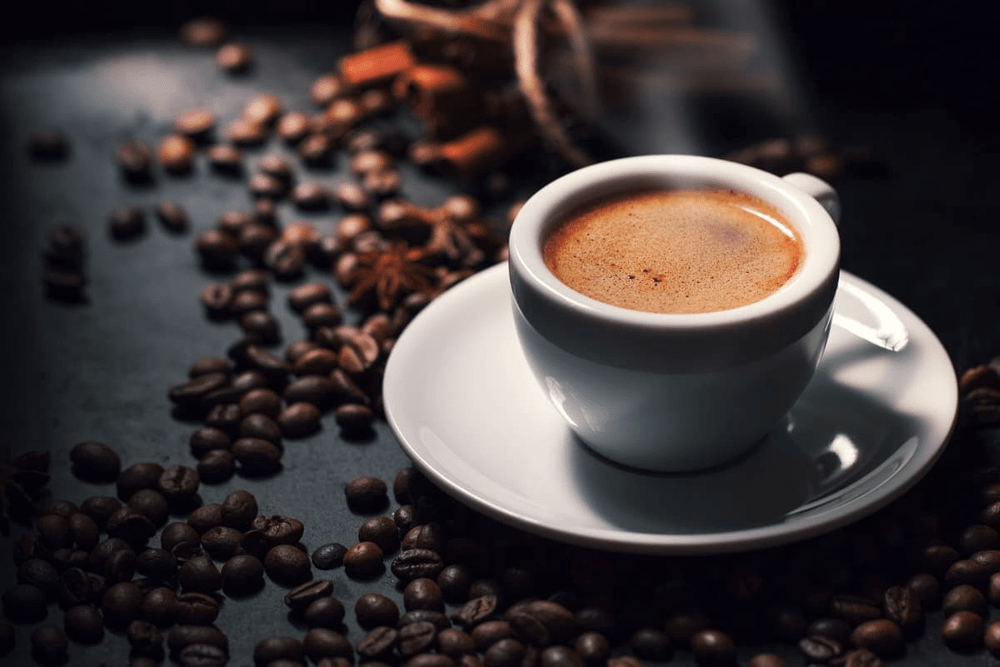
When thinking about the different types of coffee, espresso has to be the classic image. It’s a short shot of coffee made in the espresso brewing method. That’s right, espresso is not actually a type of coffee, but more accurately, a coffee brewing technique.
Brewed at high pressure, a small amount of water is pulled through densely packed, finely-ground coffee. The exact amounts of each vary from location to location. However, the pulling of an authentic espresso is quite the science. The ideal ratio would be 1:2 – 1:3. This means 20g of coffee grinds should produce 40-60g of pulled espresso.
Espresso shots are also the standard base for almost every drink on this list and, as such, is without question one of the most important coffees you can learn about.
3. Doppio
View in gallery
Italian for double, doppio is exactly what it claims in the name. A double shot of coffee brewed espresso style. In other words, a double espresso.
Why does this make it to the list? Because, as we discussed, technically, espresso is a brewing method, doppio could be considered the base type of coffee brewed with that method. Just using double the ground and water quantity.
A doppio is roughly 60ml of drinkable coffee, and outside of Italy, it is the commonly used size of shot for most coffee beverages.
4. Red Eye
View in gallery
A coffee cocktail without alcohol. A virgin coffee cocktail? Who knows. A red-eye is a drowse-busting drink that gives you the caffeinated kick you need when you need it the most.
A regular black coffee (Americano) with an additional espresso shot dropped into the mix. Not a drink for the caffeine conscious, but a lifesaver for cramming or hungover students across the globe.
This coffee gets its name as a result of its heavy use among those flying on the overnight ‘red eye’ flights into and out of New York City.
5. Macchiato
View in gallery
In Italian, macchiato means spotted or stained. The name is given because of the way the steamed milk is stained when combined with the espresso shot.
There are actually two different types of macchiato coffee.
- (Latte) Macchiato
- (Espresso) Macchiato
The difference between the two is the amount of warm milk and the size of the cup it’s served in. Classically, an espresso macchiato captures the spirit and name of the drink. A strong shot of coffee with a dollop of milk. Perfect for a quick on the go drink with the power of espresso but a gentle sweetness from the milk that makes it easier on the stomach.
The macchiato, as it is commonly called today, gets typically served in a tall glass with a higher quantity of steamed milk. Both are true types of coffee, and neither can lay claim to being the authentic macchiato as no concrete guidelines exist for this beverage.,
6. Cappuccino
View in gallery
When it comes to the different types of coffee, the cappuccino has to be the most widely recognized and middle-of-the-road coffee going. It’s the classic and safe option loved by millions of people around the world.
The ultimate cappuccino is made with a shot of espresso as the base component topped with two different types of milk. First, a layer of steamed milk, followed by the frothy milk, gives the drink its familiar appearance. Now, you can get into discussions of foam, microfoam, and macro-foam, but that’s a step too far for today. On average, your typical cappuccino will have a liquid to foam ratio of roughly 1:1. Depending on where you buy your cappuccino, it often comes dusted with chocolate powder, maybe even applied using a stencil
7. Latte
View in gallery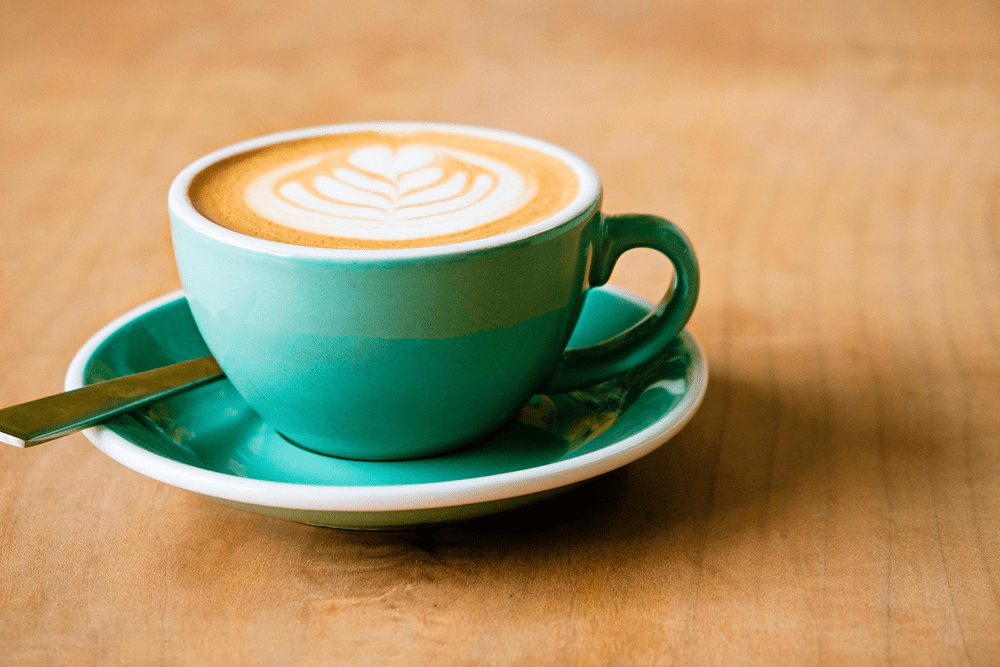
If a cappuccino is the standard espresso based drink, a latte is a close second. Very similar in its makeup, a solid latte differs only in the quantities of milk used in its creation.
Take a shot of perfectly pulled espresso and layer it with a thick layer of steamed milk and a small layer of foam. The primary difference is that a latte has more steamed milk and less foam. Often times you will also find these layers are more blended in a latte than a cappuccino. To make the ultimate latte, you should aim to use twice as much milk as you do coffee.
A latte has more milk than a cappuccino, so it is a slightly more calorific option. However, you can play around with non-fat milk if you are trying to watch your weight.
8. Cortado
View in gallery
The cortado is a small but powerful Spanish-origin coffee, popular among cafe patrons worldwide. Think a cappuccino or latte without the foam or the frills. Instead, take equal amounts of espresso and warm (steamed) milk. Combine, and there you have it. A smooth and delicious coffee drink that is often served in a small cup or even shot-style in a glass.
Out of all the different types of coffee, the cortado seems to have the most names, with different parts of the world attributing different titles to the drink. However, cortado is the original and true name by which it should be known.
9. Mocha
View in gallery
Flavored coffees are something that you will see listed on menu boards in cafes worldwide. However, the mocha rightfully stands tall on its own merit as one of the different types of coffee.
The first, quite simply put, is chocolate coffee. Often called either a mocha or a mochaccino, it is essentially a latte coffee with a shot or two of chocolate-flavored syrup added before the milk. It’s a simple, trendy, and tasty coffee.
It’s important not to get your mocha confused with Moka. While they are both kinds of coffee, Moka is more of a brewing method and delivers a strong shot of coffee traditionally brewed on the stovetop using a Moka pot. I’m sure you could go the whole way and make a Moka mocha should you be so inclined.
10. Americano
View in gallery
When it comes to the different kinds of coffee, the Americano is the gold standard classic cup of joe. A shot or two of espresso, add hot water to taste, and you have a cup of go-go juice fit for any occasion.
While an Americano is just a black coffee for all intents and purposes, do not get it confused with a cup of back coffee from a filter brewer or a french press. While they may seem the same, it is the fact that you are diluting an espresso shot that makes the Americano so distinct. It means you’re getting espresso levels of caffeine in a larger drink.
To put it into perspective, an Americano will have approximately 120mg of caffeine, while a traditionally brewed black coffee will top out at around 90-95mg.
11. Flat White
View in gallery
The flat white is one of those coffee drink names that has come to mean one thing but took its origins elsewhere. Rising to prominence in Australasia, it is essentially a stopgap between a cortado and a regular latte. An espresso shot with a small amount of steamed milk and a small amount of foam for texture.
However, as the name has spread across the globe in recent years, it has become more synonymous with any plain white coffee.
To get technical, as this kind of coffee is oddly specific, you need a small layer of microform on the top, giving the ‘flat’ element of the name. This foam also soaks up the crema layer from your espresso and intensifies the flavor of the entire drink.
12. Cafe Au Lait
View in gallery
Translated as coffee with milk, the cafe au lait is another one of the milk kinds of coffee drinks. While it may sound like a flat white or a latte, subtle differences again set this coffee apart.
While both lattes and other milky types of coffee on this list are made with an espresso base, the cafe au lait is not. Instead, it merely uses a strong black coffee as a base. Additionally, the cafe au lait uses more coffee – roughly double the amount – and less milk. There is also no foam and froth. It’s a no-frills beverage for those that want a solid drink without the bitterness of a black coffee.
Many places around America add chicory to their cafe au lait for extra flavor. However, traditionally, this was not the case.
13. Piccolo Latte
View in gallery
Now we’re getting to the real nitty-gritty types of coffee. A piccolo latte is, as the name suggests, a small latte. For many, this just means a cortado; however, there are several subtle differences that true coffee enthusiasts understand and appreciate.
The piccolo latte is a shot of espresso served with steamed milk and a small amount of foam. Traditionally, you are looking at a 3oz drink with a ratio of 1;1 for coffee and milk. The inclusion of the foam layer is what separates this drink from the cortado. That and the simple fact that this coffee has a very specific definition, while the cortado is far more open to individual interpretation.
14. Affogato
View in gallery
We are venturing into different territory now, as we are looking at a specialty coffee … or a dessert … maybe a coffee. An affogato is both dessert and drink, giving you the best of both possible worlds.
Traditionally, when you order an affogato, it would be at the end of a meal. You will be served a single scoop of vanilla ice cream (or gelato if you are in Italy) and a shot of fresh, piping hot espresso to the side. Pour the coffee over the ice cream and enjoy a dessert drink that is hot, bitter, sweet, and smooth.
14. Irish Coffee
View in gallery
Another specialty coffee that everybody over the age of twenty-one (eighteen for those lucky folk in Europe and other parts of the world) needs to know about. Take a coffee and add whiskey. That’s pretty much all you need. However, you need a little more for a truly authentic Irish coffee experience.
Take your coffee; it can be any black coffee, and add a shot (or two) or good quality Irish whiskey and sugar. Stir well and top it off with some whipped cream. It’s a decadent drink and certainly one for the end of the day enjoyed for its alcohol rather than its caffeine. Unlike coffee beer, and Irish coffee carries all the kick of regular coffee with an alcoholic twist.
15. Drip/Filter Coffee
View in gallery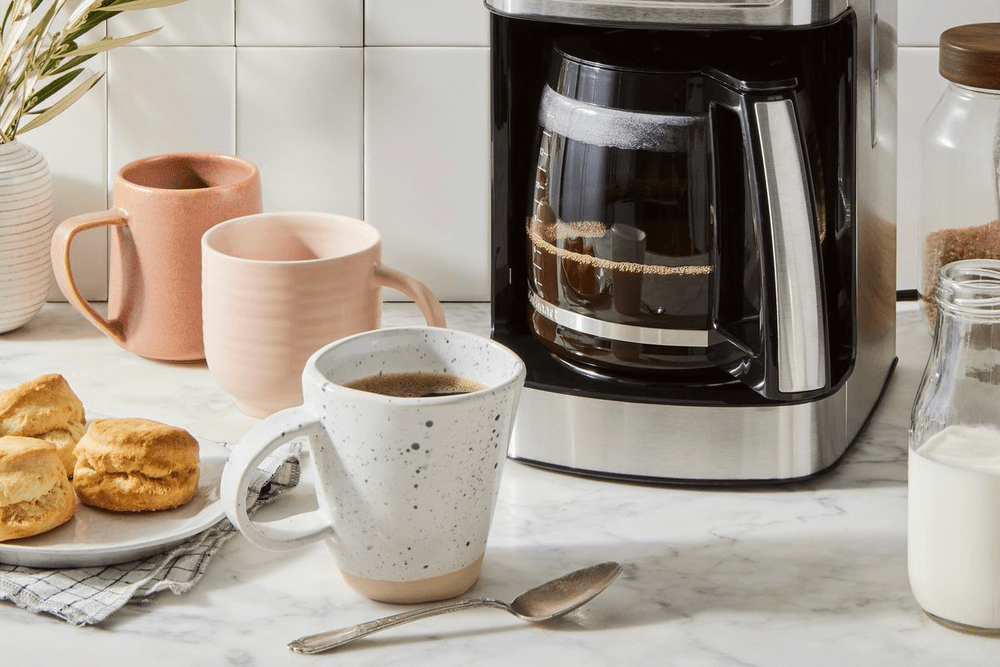
If you are making a list of the different kinds of coffee, you have to mention the household classic, drip/filter coffee. Until now, the different types of coffee on this list are items you are more likely to buy than make. Yes, you’ve got pod machines and such, but we’re talking real bean-based coffee. However, a drip or filter machine is as common a household appliance as a dishwasher or microwave.
Take a few spoonfuls of ground coffee – either store-bought or home-ground, place into a filter and allow hot water to drip through, filling the pot with freshly brewed coffee.
Of course, the final flavor of your drip brewed coffee will vary depending on the beans you use and their roasting level, and the grind coarseness, but the base premise remains the same. It’s good, honest coffee that starts more days than anything else on this list.
16. Pour Over Coffee
View in gallery
Another coffee that is more down to the brewing method but still a valid entrant on this list is pour-over coffee. In essence, pour-over coffee is a more manual and labor-intensive variant of drip coffee. You craft your brew with hot water poured over coffee grinds and pulled through a filter.
The real art to brewing this kind of coffee is in the fine degree of control you have over every step of the process. From water temperature and the micro-gram of coffee grinds. Even the pouring speed is within your control, and to coffee enthusiasts, the extra effort is worth it for the taste of a freshly brewed cup.
However, as good as it is, pour-over coffee just doesn’t seem practical for all-day, everyday consumption.
17. Instant Coffee
View in gallery
While many coffee snobs may wrinkle their noses in disgust, one of the most commonly seen kinds of coffee has to be instant. Go into any supermarket, and you will see shelves filled with different freeze-dried instant coffee granules. Made from different beats and roasts and infused will all manner of flavors and styles, instant coffee has come a long way in recent years. It’s even possible to get a decent quality brew that the heartiest of coffee lovers will still enjoy.
Add a spoon full of granules to a cup, pour in boiling water, sweeten to taste, and away you go. You have a quickfire cup of joe that will keep you going when you need it. If pour-over coffee is the pinnacle, then instant coffee is the in case of emergency break glass cousin. However, it is coffee, and it deserves its place on the list.
18. French Press
View in gallery
Another home-brew classic is the french press. There are multiple devices out there that brew coffee in the same way. However, in the name of succinctness, we will classify them all as using the french press brewing method.
The result is always the same types of coffee. While drip filter coffee is made using gravity to pull water through a coffee filter, with a french press, you combine the coffee and water at the start and then push a filter through it. The result is more intense and caffeine-rich kinds of coffee. By adding the water to the coffee grounds you are ensuring a more complete saturation which just doesn’t happen with a drip filter.
Classic french press coffee is black, but many people will add milk and sugar to taste. Of course, you could always use it to make a homemade cappuccino or other such drink should you have access to a milk frother.
19. Turkish Coffee
View in gallery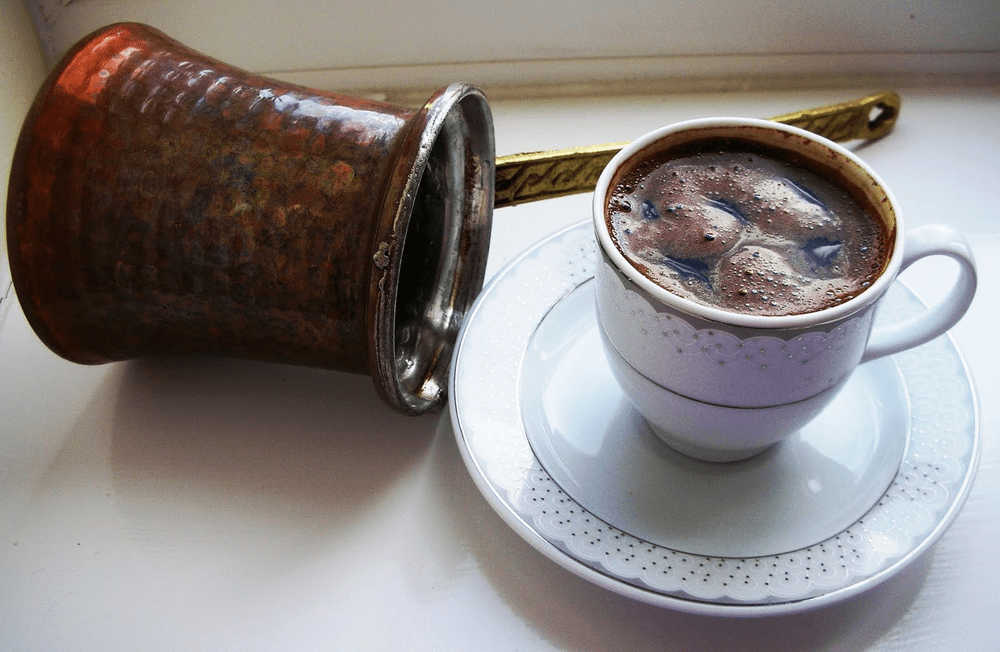
Unlike most of the other coffees on this list, Turkish coffee does not filter the coffee grinds before serving. Rather, it is prepared by combining water, coffee grinds, and sugar in a special canister called a Cezve and poured unfiltered into a cup. The coffee grinds will settle into the bottom, and the resulting drink is a strong coffee that tastes quite unlike anything else on this list.
The key to making a successful Turkish coffee is to not boil the mixture but rather stop just as a froth starts to form. If you want to extract even more flavor, you can reheat the mixture – before it cools completely – to get a thicker froth and a more intense flavor.
While Turkish coffee may taste divine, there is certainly quite a process behind its creation. This does mean it’s not necessarily the ideal coffee for all-day drinking. However, for those special occasions or just a nice lazy Sunday morning, you will struggle to beat a cup of this Arabian brew.
20. Bulletproof Coffee
View in gallery
Coffee as breakfast. There is a way to make that happen. Bulletproof coffee is one of those extra special espresso coffee drinks that doubles up as a meal replacement. Strongly favored by practitioners of the keto diet, it also goes by the name of butter coffee.
Take two cups of good quality espresso-based coffee, add two tablespoons of unsalted butter and some MCT oil and there you have it. A high-calorie breakfast replacement that will get you firing on all cylinders all while keeping your carbs low.
It’s important to understand that bulletproof coffee is not your everyday kind of drink. If anything it is more of a liquid breakfast than a cup of coffee in the traditional sense. It’s definitely not something you should be drinking multiple times a day.
21. Hot Chocolate Coffee
View in gallery
We’ve already discussed mocha coffee on this list, but hot chocolate coffee is a different drink entirely. It is, for all intents and purposes, two drinks in one and should be prepared in that way. Brew yourself a nice espresso coffee and at the same time, you will need to make a traditional milk-based hot chocolate drink.
You can use any type of chocolate you want, but semi-sweet chocolate is a great way to go. Take your hot chocolate and combine it with your cup of coffee, decorate with some marshmallows, and maybe a helping of whipped cream.
The result is a decadent dessert coffee drink that hits that post-meal hankering for something sweet with an energy boost to help you avoid the dreaded food coma.
Keep Your Cool – 5 Iced Types of Coffee for When It’s Hot Out
Of course, there is far more to coffee than just a steaming hot cup with various quantities of milk and enticing coffee flavors. There are, of course, a wide range of cold coffees with various quantities of milk and enticing coffee flavors that we need to discuss.
Over recent years cold coffees have gained a juggernaut style momentum and are now a staple on the menu boards of any coffee house worldwide. That’s not taking anything away from these kinds of coffee drinks, because they are tasty and a great way to get your caffeine fix on a hot day. Just be warned that they often contain a lot of hidden calories. And more than a few not-so-hidden ones.
So let’s take a look at some of the different cold types of coffee to keep you going when the sun is shining.
1. Iced Coffee
View in gallery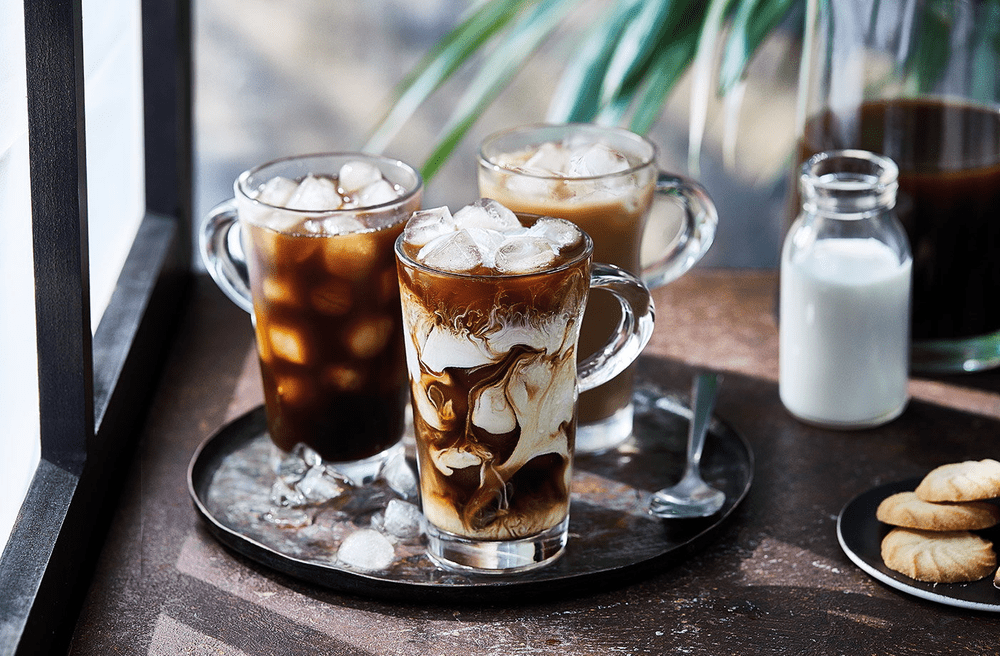
The classic cold coffee. It is also a nice and simple coffee to make. Brew your espresso nice and hot, add it to ice cubes, and away you go. Yes, you can play around with different levels of sugar and milk, but that is all about seasoning to taste. The rudimentary base of iced coffee drinks is hot coffee and ice.
Iced Coffee has a very different flavor profile to the same types of coffee drinks served hot. It is also advisable to make sure you sweeten your coffee before you combine it with ice or ice and milk. It helps the sugars to dissolve and further enhances the taste of your drink. Unlike with hot coffee, you have far more customization options when you drink it iced. This means there is an iced coffee to suit all and every taste.
Just because it’s cold, don’t think that bean type and roast intensity don’t matter. The same coffee connoisseur rules apply regardless of drinking temperature.
2. Frappuccino
View in gallery
Have you ever been drinking a milkshake and thought, I wish this tasted more like coffee? If that’s you, then a frappuccino is the drink for you. While there are several different ways and styles of making a frappuccino, the core base is always coffee blended with ice and milk/cream.
Your frappe will look and taste different depending on where you go to get your coffee. Some are thicker and made using an ice cream base. Others take crushed ice and add milk and coffee to it.
Think about it as a cross between a traditional thick ice-cream shake and a slush puppy combined with a well-pulled quality espresso shot (or two). There are a lot of different coffee flavors that can be combined when creating a Frappuccino, including whipped cream and confectionery toppings.
3. Cold Brew Coffee
View in gallery
While traditional iced coffee is brewed hot and added to ice, cold brew coffee is actually brewed cold. Typically brewing a batch of cold brew types of coffee takes a lot longer than when brewing hot. Often you need to leave it to brew overnight.
Much like espresso, cold brew is more of a brewing style than a type of coffee drink. You can take the same beans and make a hot coffee and a cold brew coffee, and the two drinks will have very different flavor profiles. Cold brew is less intense, less acidic, and less bitter. This is all because of the brewing temperature and its impact on the rate of extraction.
You can make cold brew coffee in a variety of ways including with a french press.
4. Vietnamese Coffee
View in gallery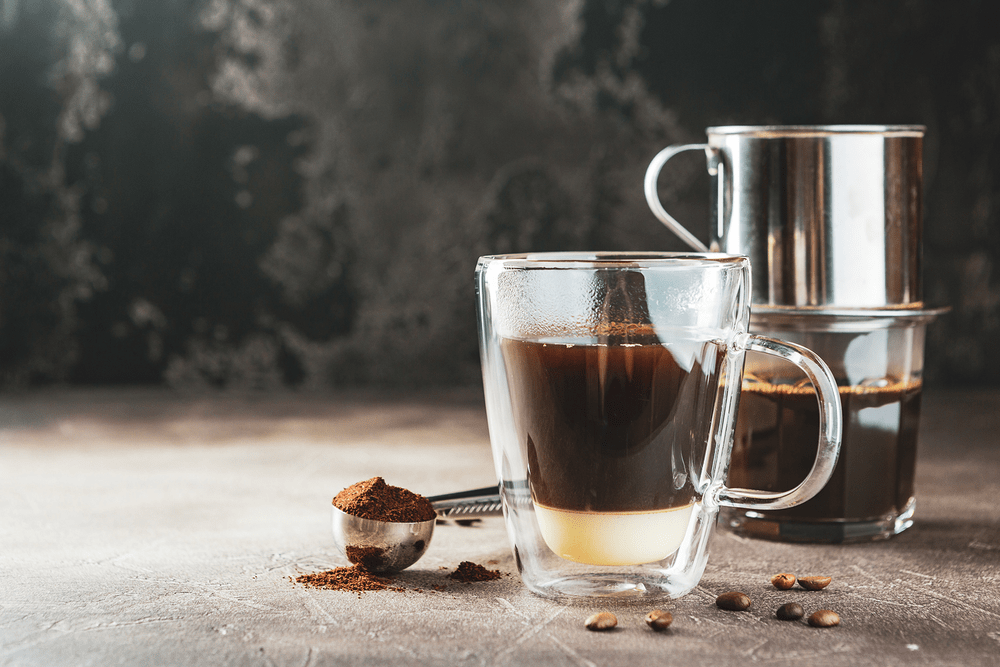
There is not much difference between Vietnamese coffee and regular iced coffee for your everyday coffee drinking folk. It is more the combination of particular beans and the items added to the finished drink. Vietnamese ground coffee beans have a very unique flavor. They are a very intense, often dark roasted coffee bean.
Vietnamese coffee is often made per cup, with small individual filters. The hot brewed coffee is added to ice and combined with sweetened condensed milk. It is a drink to be savored, and for those lucky enough to drink it on-site in Vietnam, it is an experience unlike any other.
You can also get a variety of Vietnamese coffee that also includes a chicken egg yolk.
5. Nitro Coffee
View in gallery
For those looking for a real kick in their morning coffee, indulging in a cup of nitro coffee could be just what the doctor ordered. This coffee is basically your standard cold brew coffee infused with a shot of nitrogen gas.
This gas is fired into the final coffee and gives it a silky smooth taste. Nitrogen gas does not dissolve in water very well, and this is why nitro coffee avoids the carbonated taste often associated with gas-infused beverages. Instead, you get a delicious cold coffee with an incredible 30% more caffeine.
The creamy texture created by the gas means most people drink this coffee black. However, it can be sweetened with sugars or syrup-based coffee flavors to create a range of types of coffee, all under the same banner.
A Brief History of Coffee
Coffee as a beverage was first discovered in Ethiopia, where entire forests of coffee trees once bloomed wild and unashamed. If historical legends are to be believed, a goat farmer and an Abbott got together to extract a drink from the berries of these wild-growing trees. The resulting drink was soon passed around the monastery to help the monks stay awake during their nightly prayers.
From there, news of the drink spread, and sometime in the 15th century, the beans had been harvested and planted through the Arabian peninsula. It was here that the first coffee shops were opened. People took their time and enjoyed this new drink, sitting and chatting with friends. Slowly, coffee became more than just a drink. It became part of social convention.
The 17th century saw European seafarers find the drink and bring it back to the continent, where it too was soon enjoyed by the masses. It continued to spread over to the Americas and eventually to Martinique, where a single seedling has spawned over 18 million trees. Unsurprisingly, the Dutch – a bold seafaring nation back then – were quick to adopt the drink and spread it through the different colonies.
Through the centuries, the popularity of the drink has only increased. Now, in 2023, it is the second most prized commodity after crude oil.
Is Coffee Good For You?
There will always be questions raised over the health benefits of coffee. As time has gone by, different findings have revealed alternating views. The bottom line is that when consumed in moderation, coffee has a lot of potential health benefits. However, as with everything else in life, too much of a good thing can, and will, make it bad.
Some of the more commonly known and accepted health benefits of drinking coffee include:
- Increased energy levels
- Decreased risk of Type 2 diabetes
- Decreased risk of Alzheimer’s and Dementia
- Aids in the fight against depression
- Helps keep your liver healthy
- Could lower the risk of Parkinson’s disease
- Good source of antioxidants
- Help reduce the chance of having a stroke
Of course, these things do come with a caveat. The studies were not done based on people drinking all of the different cream and sugar-loaded kinds of coffee drinks that are on the market today.
A regular black coffee (via any brewing method) does not contain more than a single-digit load of calories. However, as soon as you start adding milk, creams, and sugars, you can see that skyrocket to 200-300 calories per cup. Of course, that’s not even thinking about the uber crazy drinks out there with sprinkles and syrups and such.
Know Your Beans
View in gallery
As if there was not enough to consider with all the various types of coffee out there, you need to consider the types of coffee beans you are consuming too. Coffee is not just a drink made from a bean, Bob’s your uncle. The same types of coffee beans grown in different locations will have wildly varied tastes. Then, when you also consider the roast level too, you can see how making a cup of coffee is not a simple matter.
There is real science behind making the perfect brew, and it begins with the beans.
Arabica Beans
Of the three main types of coffee beans, Arabica is by far the most common. They are grown worldwide and account for approximately 60% of all coffee beans produced. Arabica coffee beans are easy to grow and care for. They thrive in warm, wet conditions at high altitudes. The final flavor of Arabica beans is impacted heavily by the location in which they are grown. For example, beans grown in Indonesia are heavy in flavor with lower acidity, especially when compared to Arabica beans produced in Central America or parts of Africa.
You can get 100% Arabica coffee in many forms, including whole bean, ground, instant, and even coffee pods. For high-quality Arabica coffee, you should look for single-origin beans.
Robusta Beans
As the name would suggest, Robusta beans are a hardy plant that can resist many diseases that may fell other plants. They are the second most commonly grown coffee bean after Arabica. However, they require a hotter, dryer climate to grow properly. It’s also worth noting that Robusta beans have around twice the caffeine content as Arabica beans which means they have a bolder and more robust flavor.
Much like their popular competitor, you can get Robusta beans in many different forms, depending on your taste and requirements. However, single-origin beans will always be the more expensive but better quality coffee experience.
Liberica Beans
The most recently discovered of all types of coffee beans, Liberica beans are hard to find and certainly make a decadent cup of coffee. They are grown almost exclusively in the Philippines, where they were cultivated to replace fire-damaged Arabica crops. Liberica beans account for less than 2% of coffee beans in the world. They have a strong and smokey flavor that creates a unique coffee drinking experience.
Their name comes from Liberia, their country of origin. They are a problematic bean to cultivate, which accounts for their rarity.
Until 2006 Excelsa beans were classed as the fourth type of bean, however, this changed when they were reclassified as a variation of the Liberica type.
Final Thoughts on the Different Types of Coffee
Coffee might be one of the most common drinks on the planet, but there is nothing typical about this drink when you get down to it. You can make it as straightforward or as complicated as you would like. All the way from a simple cup of black instant through to a triple shot half-caf, low-fat, no-foam skinny latte. They all count as different types of coffee drinks.
It is precisely this diversity that makes coffee such a widely consumed beverage. There is literally a coffee to suit all tastes and needs.
What is your favorite coffee drink? Are you a straight-shooting espresso fan or perhaps you like your coffee ice cold and sweet as honey? We know we didn’t feature every type of coffee out there, so if you think your favorite deserves a shout, let us know in the comments.





